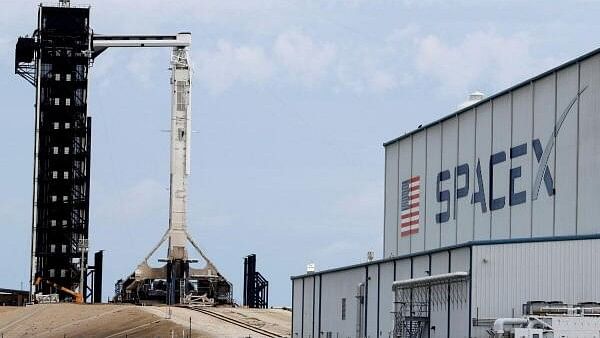
A SpaceX Falcon 9 rocket is shown as it is prepared for another launch attempt for Polaris Dawn, a private human spaceflight mission.
Credit: Reuters Photo
Very early Tuesday, Jared Isaacman, a billionaire entrepreneur, is scheduled to launch to space for a second time. The five-day mission, known as Polaris Dawn, is a collaboration between Isaacman and SpaceX, the rocket company led by Elon Musk.
It will mark some milestones for private spaceflight — the first spacewalk conducted by nonprofessional astronauts and the farthest journey from Earth by anyone since NASA’s moon landings more than 50 years ago.
How do I watch the Polaris Dawn launch?
It is scheduled for 3:38 am Eastern time Tuesday from NASA’s Kennedy Space Center in Florida. If bad weather or technical glitches arise, the launch window extends until 7:38 am.
SpaceX is providing live coverage of the launch on its website and its X social platform account.
Why has the flight been delayed?
The launch was scheduled for Aug 28, but was called off because of a helium leak. After that, unsettled weather around Florida has proved troublesome — not so much for the launch, but for the splashdown on the sixth day.
The Polaris Dawn mission carries limited amounts of air, food and other supplies. “Unlike an ISS mission, we don’t have the option to delay long on orbit, so we must ensure the forecast is as favorable as possible before we launch,” Isaacman explained on X.
The weather outlook for the return to Earth appears better, but the odds that Polaris Dawn will get off the ground are still iffy. There is only a 40% chance of favorable weather for liftoff. Weather is similarly problematic for Wednesday and improves slightly Thursday.
If Polaris Dawn cannot launch this week, it faces a longer delay, because SpaceX needs to start readying the launchpad for NASA’s Europa Clipper mission in October.
Who will be on board?
In addition to Isaacman, the crew will consist of Scott Poteet, a retired U.S. Air Force lieutenant colonel and pilot who is a longtime friend of Isaacman’s; and two SpaceX employees, Anna Menon, a lead space operations engineer, and Sarah Gillis, an engineer who oversees astronaut training.
How high above Earth will Polaris Dawn travel?
The launch will put the spacecraft and crew on an elliptical orbit that comes within 118 miles of the Earth’s surface and then swings out to an altitude of 745 miles. That will be the farthest from Earth that anyone has traveled since the Apollo moon missions.
Several orbits later, a thruster firing will push the farthest point of the orbit even farther out, to 870 miles. That will be higher than the 853-mile altitude that NASA astronauts Pete Conrad and Richard Gordon reached during the Gemini XI mission in 1966, the record for astronauts on a spaceflight that was not headed to the moon.
The elliptical orbits will provide new insights into the bombardment of radiation and micrometeroids farther out in space.
Another thruster firing will drop the Crew Dragon into a lower orbit for the rest of the mission.
What will happen during the spacewalk?
It is scheduled for Thursday, the third day of the mission, although a time has not yet been announced.
All four crew members will put on their spacesuits, and then all of the air will be let out of the capsule. The hatch will then be opened and the inside of the spacecraft will become part of the vacuum of outer space.
Only two people — Isaacman and Gillis — are to leave the capsule to do the walk. Poteet and Menon will remain in the capsule to manage the umbilical cords and monitor the readings to make sure everything is proceeding properly.
The main goal of the spacewalk is to test the spacesuits, which SpaceX developed for this flight. The spacesuits are an evolution of those worn on earlier SpaceX missions, adding capabilities like protection against micrometeroids and temperature controls for the astronauts.
After Isaacman and Gillis return inside and close the hatch, the inside of the capsule will be repressurized.
What else will they be doing in orbit?
Before and after the spacewalk, the crew will conduct about 40 experiments, including obtaining magnetic resonance images of the astronauts’ brains and attempting to take X-ray images without an X-ray machine by using the natural showers of radiation that stream through outer space.
The mission is also raising money for St Jude Children’s Research Hospital in Memphis, Tennessee.
How is this different from Isaacman’s first space trip?
In 2021, Isaacman led and financed a mission that he named Inspiration4. It was the first trip to orbit without a professional astronaut aboard. Instead of bringing friends, Isaacman provided seats to a former cancer patient at St. Jude Children’s Research Hospital, who now works there as a physician assistant, and to two space enthusiasts who won contests.
The Inspiration4 mission went into low-Earth orbit for three days and then splashed down off Florida.
Isaacman described Polaris Dawn as a “joint effort” with SpaceX, seeking to develop new technologies that could be used for Musk’s dream of sending people to Mars someday. He declined to say how much he or SpaceX was investing.